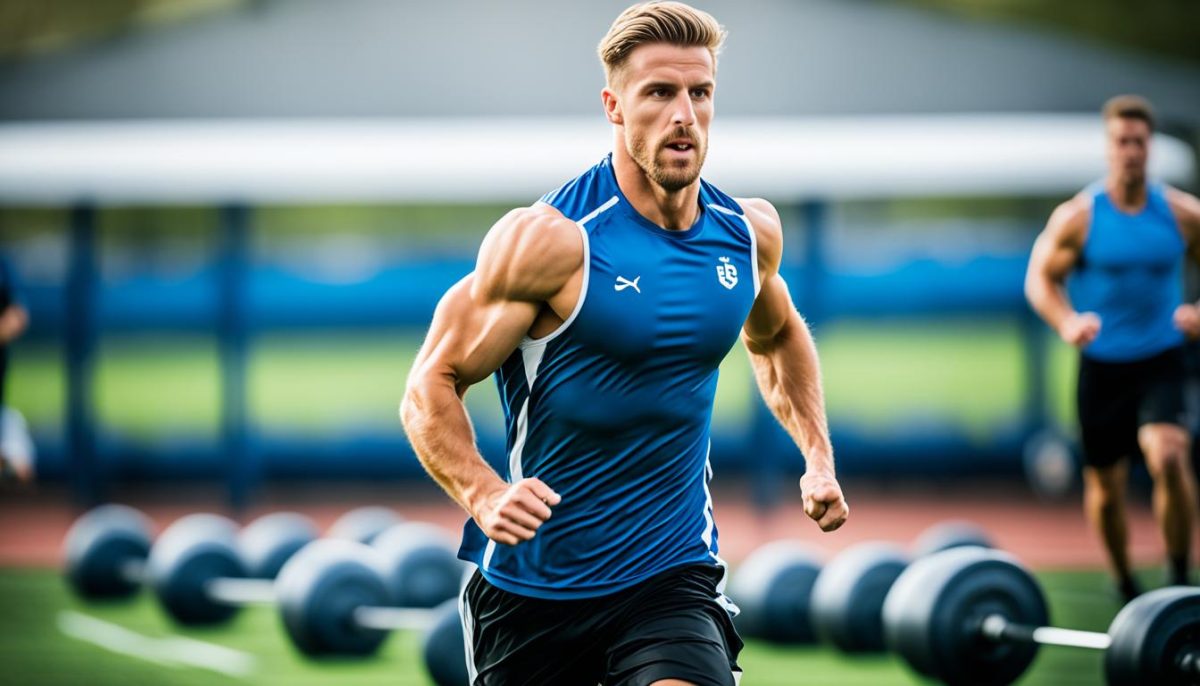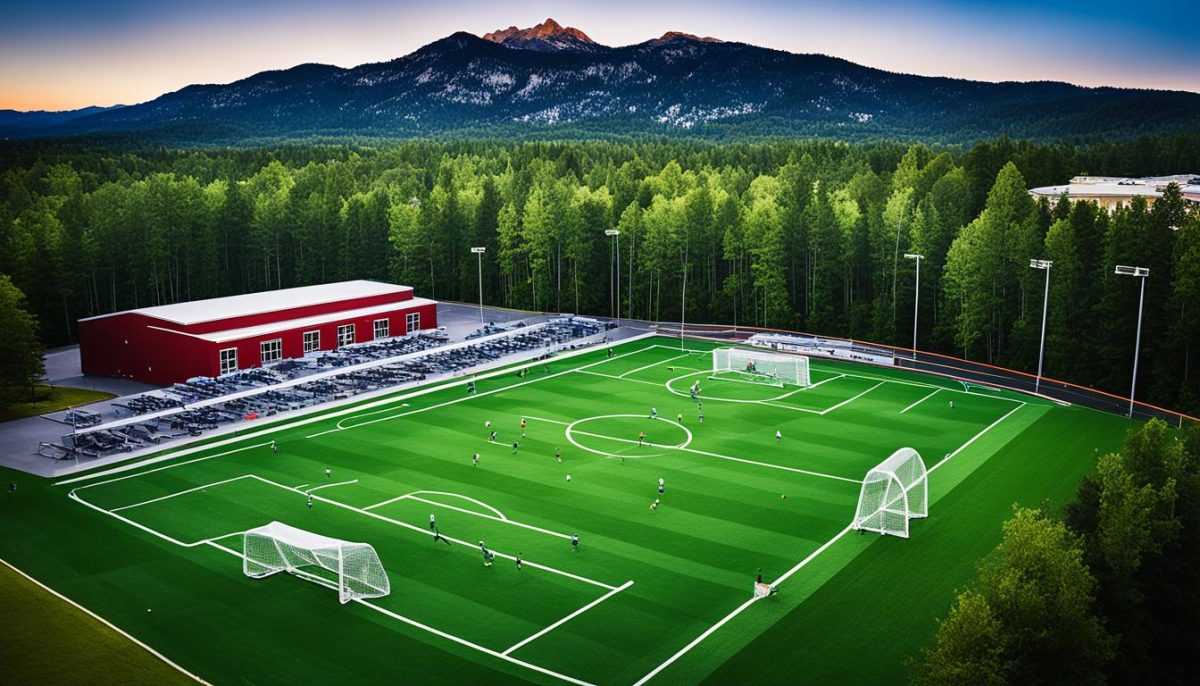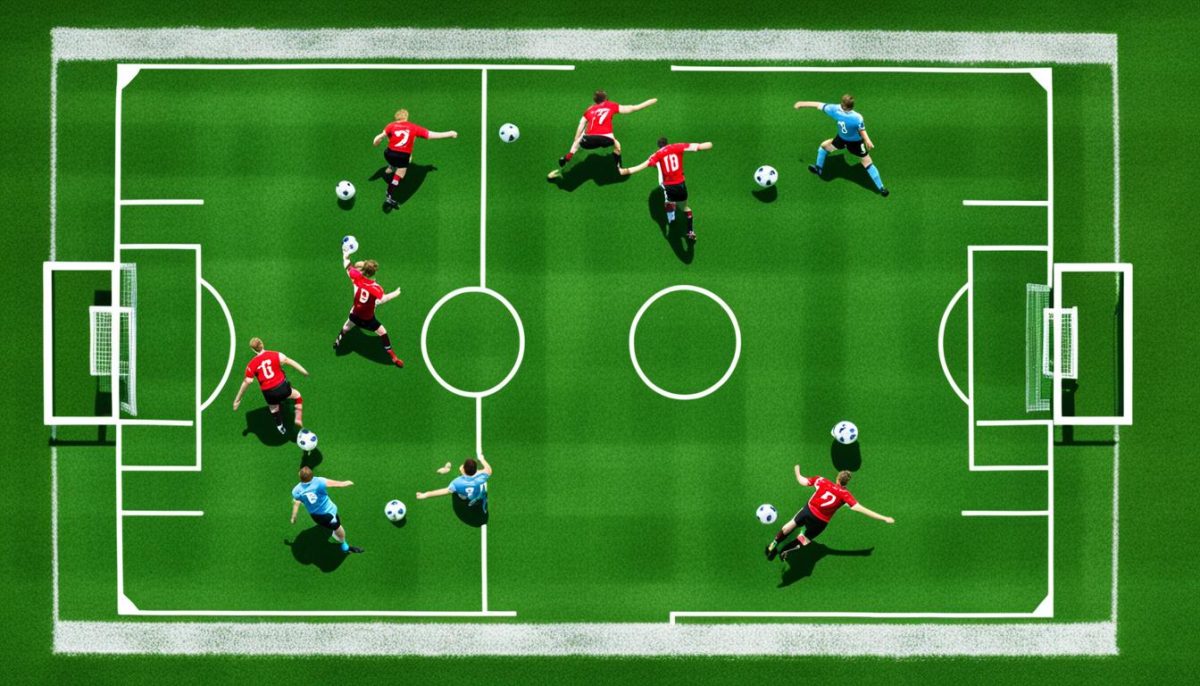Do you want to elevate your soccer game and achieve success on the field? We all know that soccer requires a combination of skill, strategy, and determination. But what if there were winning tactics that could give you the edge over your opponents? Strategies that could take your game to new heights and make you a formidable player on the field. Curious to know what these tactics are? Let’s dive in and discover the secrets to soccer success!
Key Takeaways
- Master the key skills of ball control, dribbling, passing, and body control
- Enhance your game intelligence by developing spatial awareness and tactical knowledge
- Build your physical fitness through endurance, balance, speed, and strength training
- Develop the proper mindset by cultivating compassion, composure, coachability, and self-motivation
- Understand popular soccer formations and utilize winning strategies for success
Technique: Mastering Ball Control, Dribbling, Passing, and Body Control
Technique plays a vital role in achieving success on the soccer field. It encompasses various skills that contribute to a player’s overall performance. In this section, we will focus on mastering ball control, dribbling, passing, and body control, all of which are essential for becoming a well-rounded player.

Ball Control
Good ball control is crucial for maintaining possession and making precise plays. It involves receiving the ball effectively, keeping it close to the body, and manipulating it with different parts of the foot. By mastering ball control, players can confidently maneuver through tight spaces and evade opponents.
Dribbling
Dribbling is the art of moving the ball forward while maintaining control. It requires quick footwork, close ball control, and the ability to change direction swiftly. A skilled dribbler can penetrate the opponent’s defense, create scoring opportunities, and draw fouls. Practice and repetition are key to refining dribbling skills.
Passing
Passing accuracy is crucial for effective team play. It involves delivering the ball accurately and with the right amount of force to a teammate. A well-executed pass allows for smooth ball movement, switches of play, and the creation of scoring opportunities. Good passing skills require proper technique, vision, and awareness of teammates’ positions.
Body Control
Body control refers to a player’s ability to maintain balance and coordination while executing different actions on the field. It involves using the body’s movements to shield the ball, win aerial duels, and outmaneuver opponents. Mastering body control enhances a player’s agility, endurance, and overall performance.
Developing technique in ball control, dribbling, passing, and body control requires consistent practice and focus. By honing these skills, players can significantly contribute to their team’s success and elevate their level of play.
“Technique is not being able to juggle a ball 1000 times. Anyone can do that by practicing. Then you can work in the circus. Technique is passing the ball with one touch, with the right speed, at the right foot of your team mate.” – Johan Cruyff
| Aspect | Description |
|---|---|
| Ball Control | Maintaining possession, manipulating the ball effectively |
| Dribbling | Moving the ball forward with control and evading opponents |
| Passing | Accurately delivering the ball to teammates |
| Body Control | Maintaining balance, coordination, and agility |
Game Intelligence: Enhancing Spatial Awareness and Tactical Knowledge
In soccer, game intelligence plays a crucial role in determining the outcome of a match. It involves making smart decisions on the field based on spatial awareness and tactical knowledge. Let’s explore how these two aspects contribute to a player’s success.
Spatial awareness is the ability to understand the positioning of teammates and opponents in relation to oneself. It allows players to assess the available space on the field and make strategic moves accordingly. By having a keen sense of spatial awareness, players can create passing lanes, exploit gaps in the defense, and find themselves in optimal positions to receive the ball. This not only enhances team cohesion but also increases the chances of scoring goals.
Tactical knowledge is crucial for understanding the game’s structure, formations, and opponent’s strategies. It involves anticipating the movements of opponents, recognizing patterns, and identifying potential areas of vulnerability. Players with a good understanding of tactics can adjust their positioning and make informed decisions to either attack or defend effectively. Tactical knowledge allows teams to exploit weaknesses in the opponent’s formation, create scoring opportunities, and maintain a strong defensive shape.
“Spatial awareness and tactical knowledge are like two sides of the same coin in soccer. They go hand in hand, enabling players to make the best use of the space available and make intelligent decisions that give their team an advantage.”
By honing their game intelligence, players can elevate their performance and contribute significantly to their team’s success. It requires constant practice, observation, and analysis of the game. Developing spatial awareness and tactical knowledge should become a part of a player’s training regimen from an early age. Coaching sessions that incorporate small-sided games, positional drills, and tactical exercises can help players sharpen their understanding of space and tactics.
The benefits of game intelligence include:
- Improved decision-making on the field
- Enhanced teamwork and coordination
- Increased goal-scoring opportunities
- Effective defensive strategies
- Ability to exploit weaknesses in the opponent’s formation
Incorporating game intelligence into training sessions can significantly contribute to a player’s overall development in soccer. By focusing on spatial awareness and tactical knowledge, players can elevate their game and make a greater impact on the field.
| Spatial Awareness | Tactical Knowledge | |
|---|---|---|
| Definition | The understanding of positioning in relation to others on the field. | The comprehension of game structures, formations, and opponent strategies. |
| Importance | Enables creation of passing lanes, exploitation of gaps, and optimal positioning. | Allows for adjustments in positioning, informed decision-making, and strategic advantage. |
| Benefits | – Improved decision-making – Enhanced team cohesion – Increased scoring opportunities |
– Effective defensive strategies – Exploitation of opponent weaknesses |
Physical Fitness: Building Endurance, Balance, Speed, and Strength
In order to succeed in soccer, physical fitness plays a crucial role. It is the foundation upon which all other skills are built. A player’s physical fitness level determines their ability to endure the demands of a game, showcase agility and balance in their movements, demonstrate explosive speed, and exhibit the necessary strength and power to excel on the field.
Endurance: Maintaining High Performance Throughout the Game
Endurance is essential for soccer players to maintain a high level of performance throughout the entirety of a game. It allows players to sustain their energy levels, enabling them to run, sprint, and make smart decisions until the final whistle blows. Endurance enables players to cover long distances, press opponents, and actively participate in both attacking and defensive plays.
Balance and Coordination: Enhancing Agility on the Field
Balance and coordination are fundamental aspects of a soccer player’s physical fitness. They contribute to a player’s ability to change direction quickly, maintain control while dribbling, and execute precise movements. Balance allows players to stay upright and maintain stability, while coordination ensures seamless interaction between different parts of the body, enabling players to execute skills effectively.
Speed: Crucial for Quick Movements and Sprints
Speed is a vital component of physical fitness in soccer. It enables players to outpace opponents, execute swift changes in direction, and cover larger distances in shorter timeframes. Speed contributes to a player’s ability to win races for loose balls, beat defenders in one-on-one situations, and make well-timed runs to receive passes or score goals. The faster a player can move, the more they can impact the game.
Strength and Power: Boosting Overall Physical Performance
Strength and power are essential for a soccer player to excel in physical battles on the field. Strength provides the ability to hold off opponents, win aerial duels, and shield the ball effectively. Power allows players to generate explosive bursts of energy, enhancing their ability to accelerate, jump, and strike the ball with force. Developing strength and power translates into greater physical dominance, enabling players to control the game and impose their presence on opponents.
By focusing on building endurance, improving balance and coordination, nurturing speed, and developing strength and power, soccer players can enhance their physical fitness levels and gain a competitive edge on the field.

Proper Mindset: Developing Compassion, Composure, Coachability, and Self-Motivation
Having the right mindset is crucial for success in soccer. It goes beyond physical skills and encompasses qualities such as compassion, composure and mental strength, coachability, and self-motivation. Let’s explore how these attributes contribute to a player’s growth and achievements on the field.
Compassion: Compassion is the foundation of strong teamwork and good sportsmanship. It involves understanding and empathizing with teammates, opponents, and officials. When players show compassion, they foster a positive environment, build trust, and form deeper connections.
Composure and Mental Strength: The ability to remain calm, focused, and make clear decisions under pressure is key to succeeding in soccer. Composure allows players to maintain control of their emotions and respond effectively in intense situations. Mental strength helps players overcome challenges, bounce back from setbacks, and stay determined to achieve their goals.
Coachability: Being coachable means being open to learning, taking feedback constructively, and continuously improving. Coachable players are receptive to guidance from coaches and teammates, actively seek ways to enhance their skills, and implement suggestions to perform at a higher level. This willingness to learn and grow is vital for long-term success.
Self-Motivation: Self-motivation is the internal drive that pushes players to give their best effort, even when faced with obstacles. It fuels dedication, discipline, and perseverance. Self-motivated players set goals, maintain a strong work ethic, and constantly strive to push their own boundaries.
“Success in soccer requires a proper mindset that encompasses compassion, composure, coachability, and self-motivation. These qualities not only contribute to individual growth but also enhance team dynamics and overall performance.”
Impact of Proper Mindset on Soccer Success
| Mindset Qualities | Benefits |
|---|---|
| Compassion | – Builds strong teamwork – Fosters good sportsmanship – Enhances communication and cooperation |
| Composure and Mental Strength | – Enables clear decision-making under pressure – Promotes resilience and focus – Reduces stress and anxiety |
| Coachability | – Facilitates continuous learning and improvement – Strengthens teamwork and collaboration – Enhances adaptability to different strategies |
| Self-Motivation | – Drives personal growth and development – Sustains high levels of dedication and effort – Inspires teammates and leads by example |
Developing a proper mindset is essential for any soccer player aiming for success. Compassion, composure and mental strength, coachability, and self-motivation not only enhance individual performance but also contribute to a harmonious and high-performing team. By cultivating these qualities both on and off the field, players can unlock their full potential and achieve remarkable results.
High-Performance Soccer Academies: Utilizing Specialized Training and Education
At high-performance soccer academies, we provide young players with the opportunity to unlock their full potential through specialized training programs. Our focus goes beyond developing technical skills; we aim to cultivate game intelligence, physical fitness, and the proper mindset. By combining comprehensive training and quality education, we prepare students for success on and off the field.

Our specialized training programs are designed to hone players’ skills in various aspects of the game. We prioritize technical proficiency, enabling players to master essential techniques such as ball control, dribbling, passing accuracy, and body control. Through intensive drills and practice sessions, players develop the necessary skills to excel in real-game situations.
Furthermore, our academies focus on enhancing game intelligence, which encompasses spatial awareness and tactical knowledge. Players learn to read the game, anticipate opponents’ movements, and make informed decisions on the field. This strategic understanding enables them to create scoring opportunities, exploit weaknesses in the opposition’s defense, and contribute to successful team play.
Physical fitness is a vital component of our training programs. We believe that players need to possess the endurance, balance, coordination, speed, and strength required to perform at their best. Our fitness training routines are tailored to enhance these attributes, ensuring that players can maintain their peak performance throughout matches and withstand the demands of high-level competition.
“At high-performance soccer academies, we prioritize education alongside training. We understand that well-rounded individuals perform better both on and off the field.”
In addition to training, we prioritize education to ensure holistic development. Our specialized programs strike a balance between athletic and academic pursuits, preparing students for a bright future. We provide a supportive learning environment that allows players to excel academically while pursuing their soccer dreams.
By offering comprehensive training and education, our high-performance soccer academies equip young players with the necessary tools to succeed in the highly competitive world of soccer. From technical skills to game intelligence, physical fitness, and a strong mindset, our programs empower players to reach their full potential and thrive on and off the field.
The Benefits of High-Performance Soccer Academies:
- Specialized training programs focusing on technical skills, game intelligence, physical fitness, and the proper mindset
- A supportive learning environment that prioritizes education alongside training
- Preparation for success on and off the field
- Opportunities to excel academically while pursuing soccer dreams
- Development of well-rounded individuals
| Training Programs | Focus Areas |
|---|---|
| Technical Skills | Ball control, dribbling, passing accuracy, body control |
| Game Intelligence | Spatial awareness, tactical knowledge |
| Physical Fitness | Endurance, balance and coordination, speed, strength |
| Proper Mindset | Compassion, composure and mental strength, coachability, self-motivation |
Popular Soccer Formations: Understanding the Uses and Strategies
Different soccer formations provide various tactical advantages on the field. By strategically positioning players, formations create a structure that enables teams to optimize their strengths and exploit opponents’ weaknesses. Understanding the uses and strategies of popular formations is essential for teams aiming for success. Let’s explore some of the most popular soccer formations and their key characteristics:
4-3-3 Formation
The 4-3-3 formation is an attacking formation that emphasizes a strong forward line. It consists of four defenders, three midfielders, and three forwards. This formation provides width in attack and puts pressure on the opposing team’s defense. The three forwards act as goal-scoring threats, while the midfielders provide support and create passing options. Defensively, the midfielders also play a crucial role in breaking down the opponent’s attacks.
3-5-2 Formation
The 3-5-2 formation is a versatile formation that focuses on compactness and flexibility. It consists of three central defenders, five midfielders, and two forwards. This formation provides a strong defensive presence with the three center backs. The five midfielders offer width and contribute to both defense and attack. The two forwards work together to create goal-scoring opportunities. The 3-5-2 formation is effective for controlling the midfield and maintaining possession.
4-2-3-1 Formation
The 4-2-3-1 formation is a balanced formation that combines defensive stability with attacking prowess. It consists of four defenders, two defensive midfielders, three attacking midfielders, and one forward. This formation ensures a solid defensive base with the two defensive midfielders providing cover for the backline. The attacking midfielders have the freedom to support the lone forward and create scoring opportunities. The 4-2-3-1 formation offers a good balance between defense and attack.
4-4-2 Formation
The 4-4-2 formation is a traditional formation known for its simplicity and effectiveness. It consists of four defenders, four midfielders, and two forwards. This formation provides a solid base in defense with a flat four-man midfield offering both support and width. The two forwards work together to apply pressure on the opposing defense and create goal-scoring chances. The 4-4-2 formation is versatile and can easily adapt to different game situations.
Understanding the principles and strengths of these popular formations allows teams to adopt the strategy that best suits their style of play and player capabilities. The choice of formation depends on factors such as the team’s strengths, opponent analysis, and game objectives. By implementing the right strategies within these formations, teams can maximize their chances of success on the field.

Winning Strategies for 5-a-side Football: Tips for Success
In 5-a-side football, implementing effective strategies is crucial for achieving success on the field. Whether you’re playing in a competitive league or enjoying a casual match with friends, these tips will help you and your team maximize your chances of winning.
1. Organize Your Team
Before stepping onto the field, it’s essential to have a well-organized team. Assign specific roles to each player, such as defenders, midfielders, and attackers, based on their strengths and abilities. Establish a clear game plan and communicate it to the team, ensuring everyone understands their responsibilities.
2. Communicate Effectively
Communication is key in 5-a-side football. Constantly talk to your teammates, providing them with crucial information and instructions. Effective communication helps maintain team cohesion, allows for quick passes and coordinated movements, and helps anticipate and react to opponents’ actions.
3. Have Fun
Remember that 5-a-side football is ultimately about enjoying the game. Embrace the spirit of friendly competition and have fun while playing. A positive attitude and enjoyment of the game can enhance your performance and that of your team.
Defensive Strategies:
- 4. Work as a Team: Defending in 5-a-side football requires collective effort. Coordinate with your teammates, cover each other’s positions, and communicate effectively to prevent opponents from finding gaps in your defense.
- 5. Press with Purpose: Apply effective pressing tactics to disrupt opponents’ attacking plays. Press as a unit, aiming to force turnovers and quickly regain possession.
- 6. Keep a Player at the Back: While attacking, leave one player as a defensive anchor to provide support and prevent counter-attacks.
- 7. Avoid Diving into Tackles: In 5-a-side football, diving into tackles can leave your team vulnerable. Opt for controlled challenges and prioritize maintaining your defensive shape.
Offensive Strategies:
- 8. Use Counter-Attacks: Exploit the space left by the opposing team’s attacking movements and launch quick counter-attacks to catch them off guard.
- 9. Play Within Your Limits: Understand your abilities and play to your strengths. Avoid taking unnecessary risks and focus on making efficient decisions to maintain possession and create scoring opportunities.
- 10. Effective Passing: Accurate and timely passing is vital in 5-a-side football. Develop good passing techniques, use wall passes, and maintain quick ball circulation to create openings in the opposing defense.
- 11. Create Space: Utilize off-the-ball movements to create space for yourself and your teammates. Make diagonal runs, create overlaps, and exploit gaps in the opposing team’s defense.
By implementing these strategies, you can enhance your performance and increase your chances of success in 5-a-side football.
Conclusion
In conclusion, achieving soccer success requires a comprehensive approach that encompasses both technical skills and strategic thinking. By mastering the key skills of ball control, dribbling, passing, and body control, players can elevate their performance on the field. Additionally, developing game intelligence through spatial awareness and tactical knowledge enables players to make smart decisions and create opportunities for themselves and their team.
Physical fitness is another crucial aspect of soccer success. Building endurance, balance and coordination, speed, and strength allows players to maintain a high level of performance throughout the game. It is equally important to cultivate the proper mindset, including traits such as compassion, composure and mental strength, coachability, and self-motivation. These qualities contribute to effective teamwork, resilience in challenging situations, and a continuous drive for improvement.
To maximize success, it is essential to understand popular soccer formations and their strategic uses. By leveraging the strengths of different formations, teams can capitalize on their advantages and exploit opponents’ weaknesses. Furthermore, implementing winning strategies tailored to the specific context, such as 5-a-side football, can significantly impact game outcomes. Effective communication, teamwork, and a focus on both defense and offense are key elements in these strategies.
Ultimately, soccer success is not achieved overnight. It requires practice, dedication, and a willingness to learn from experienced coaches. By continually honing their skills, improving game intelligence, maintaining physical fitness, and nurturing the right mindset, players and teams can increase their chances of triumph on the soccer field. So, lace up your boots, step onto the pitch, and embrace the journey towards soccer success!
FAQ
What are the key skills required to become a successful soccer player?
The key skills to focus on include ball control, dribbling skills, passing accuracy, body control, spatial awareness, tactical knowledge, risk assessment, endurance, balance and coordination, speed, strength and power, compassion, composure and mental strength, coachability, and self-motivation.
What role does technique play in soccer success?
Technique is a crucial aspect of soccer success. Good ball control allows players to receive and maintain possession of the ball, while dribbling skills enable them to maneuver through opponents. Passing accuracy is essential for effective team play, and body control helps optimize balance and coordination.
How does game intelligence contribute to success on the field?
Game intelligence involves making smart decisions on the field. Spatial awareness allows players to understand the positioning of teammates and opponents, creating opportunities to receive passes or create space. Tactical knowledge involves understanding the game’s structure and formations, anticipating opponents’ moves, and creating the right opportunities to attack or defend.
What is the importance of physical fitness in soccer?
Physical fitness is crucial for soccer success. Endurance ensures players can maintain a high level of performance throughout the game. Balance and coordination help with agility on the field. Speed is essential for quick movements and sprints, while strength and power contribute to overall physical performance.
How does the proper mindset contribute to soccer success?
Having the right mindset is essential for success in soccer. Compassion helps build strong teamwork and good sportsmanship. Composure and mental strength allow players to remain focused and make clear decisions under pressure. Coachability ensures players are open to learning and improving, while self-motivation drives them to work hard and strive for success.
What do high-performance soccer academies offer young players?
High-performance soccer academies offer specialized training programs for young players aiming to reach their full potential. These academies focus on developing technical skills, game intelligence, physical fitness, and the proper mindset. They also prioritize education and prepare students for success both on and off the field.
What are some popular soccer formations and their strategies?
Different soccer formations provide various tactical advantages on the field. Formations like 4-3-3, 3-5-2, 4-2-3-1, and 4-4-2 offer different balances of defense and attack, width, and central presence. Understanding the uses and strategies of popular formations can help teams maximize their strengths and exploit opponents’ weaknesses.
What are some winning strategies for 5-a-side football?
5-a-side football requires specific strategies for success. Organizing the team, effective communication, and having fun are vital for a solid foundation. Defensively, working as a team, pressing with purpose, keeping a player at the back, and avoiding diving into tackles are key. Offensively, using counter-attacks, playing within your limits, effective passing, and creating space can lead to goals.
How can players and teams achieve success in soccer?
Soccer success relies on a combination of technique, game intelligence, physical fitness, and the proper mindset. By mastering the key skills, understanding popular formations, and implementing winning strategies, players and teams can achieve success on the field. Remember to practice, learn from experienced coaches, and always aim to improve.






